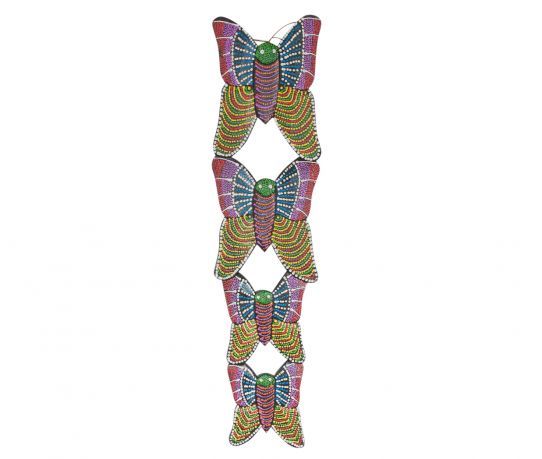We use cookies to make your experience better.
Butterfly wall panel with Australian Maori Dots made entirely by hand.
Maori are the people who already inhabited New Zealand when it was discovered by Europeans. Their language is also called Maori. The Maori arrived a few centuries earlier than the Europeans on New Zealand, which was still uninhabited at the time. The word Maori means 'normal' or 'ordinary person' in Maori. The word also occurs in other Polynesian languages, such as maoli in Hawaiian and Maohi in Tahitian. These words stand for 'original, real'. The official spelling is Māori. The name Maori is also used to describe the people and language of the Cook Islands. Some sources report that the Maori came to New Zealand as early as the early Middle Ages. According to their own accounts, they originally lived in Hawaii and sailed away in wakas (large boats) in search of food and new land. From their waka they saw in the distance a stretch of land, with a long, white expanse of cloud above it, which they would henceforth call Aotearoa ("Land of the Long White Cloud"). Tribes could often and frequently quarrel and war among themselves, but Aotearoa was big enough for everyone. In the first half of the 18th century, more Europeans came to New Zealand, who had a great influence on the Maori. On the one hand, the Europeans brought the strangest things from overseas and were therefore highly regarded by the Maori. On the other hand, enough tribes realized that the Europeans were after their sacred land (which they sometimes bought for a few kilos of salt), much to the anger of the Maori. In an effort to end the land disputes, the Treaty of Waitangi was signed on Thursday, February 6, 1840, by some Maori chieftains and representatives of the British Crown. In 1856 the Maoris appointed a central leader: King Potatau I. This was a big change for the Maori because they had never really known a leader, only chieftains. After the Maori wars lost by the tribes, the land of the Maori was in very bad shape. Almost all of it was useless for growing food. Due to all the diseases that had come over from Europe and as a result of the war, more and more Maoris died. In 1769 there were still 120,000 Maori, in 1896 there were only 42,000. In the 20th century, the number of Maori rose again to about 500,000. That is about 0.0083% of the world's population and 12.2 % of the current New Zealand population. The Maori know many different myths, in which often their forefathers play the leading role. These forefathers are their gods for the Maori, whom they worship in different ways. The myths are often heroic stories with a strong moral, in which an old Maori leader who came to them on the back of a whale plays the lead role. With the arrival of the Europeans to New Zealand, many Maori were converted to Christianity, but a few leaders were adhering to the old values and norms and have made sure that the old culture has not been lost. The first Maori priests were ordained in the Catholic Church in 1944.
| Dimensions | 490x120mm |
|---|












